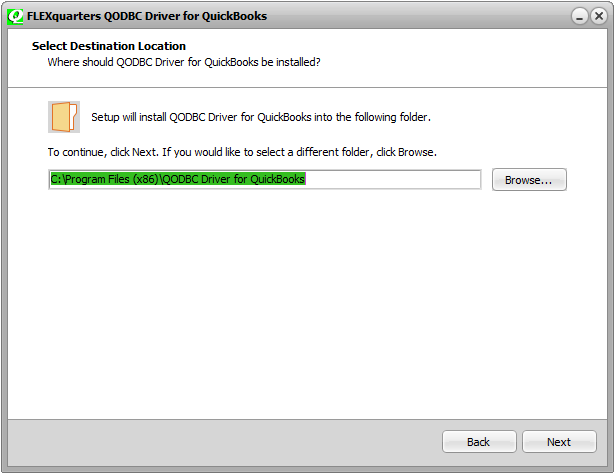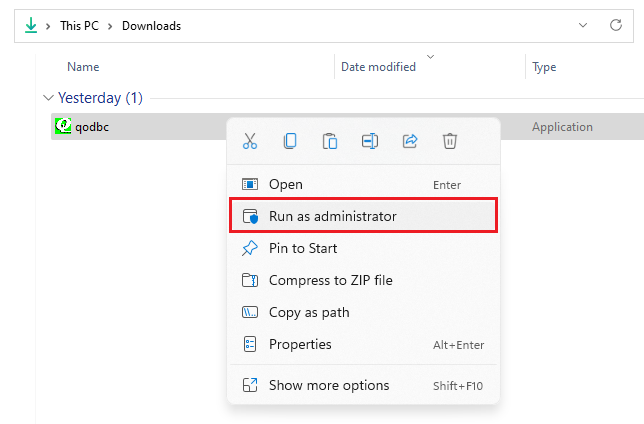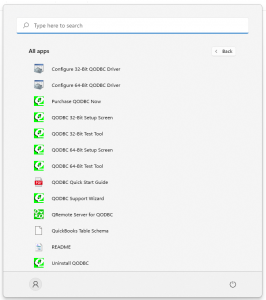Installing QODBC Driver for QuickBooks
Step 1 – Download QODBC
If you haven’t already downloaded QODBC by modem, do it now by going to the download page.
Don’t forget to read the “Readme” file during installation for the latest information on QODBC setup, new features, and other driver information.
Save the self-extracting executable “QODBC.exe” in a temporary directory or your “My Documents” folder to extract the installation files.
Step 2 – Running the Installer
Unload Microsoft Office toolbar from memory, as well as any other Windows applications that can impair installation. Click on the Install program from within Windows to install the driver.
You will be asked to select the Region of QuickBooks you are using, this should match the version of the driver you purchased.
Next, you can skip the Activation Key if you want to evaluate the product before purchase. Click “Next” to continue.
Select the destination directory to install the QODBC support files. Click “Next” to continue.
The FLEXquarters QODBC Driver for QuickBooks has been successfully installed onto your computer. You can begin to use it immediately, because it will immediately run as a 30 day evaluation version.
|
To install a full purchase or evaluation QODBC registration code, see the Icons that have been added to your Start Menu under QODBC Driver for QuickBooks
The first step in configuring the driver is to click on the ODBC Setup Screen icon, and the following screen will be become available.
|
QODBC General Setup Screen
Use the company file that’s now open in QuickBooks allows QODBC to use the company file that you have open and allows you to switch between files without having to create separate DSN’s for each file.
Locate a company file is the path where your QuickBooks data file resides. For example: “C:\Program Files\Intuit\QuickBooks Pro\Myapp.qbw”. The browse button (…) will let you choose your QuickBooks company file from the folder it is in.
Data Source Name is a display name for your QuickBooks data (QuickBooks Data, QBPRO, My QB Data, etc.)
Mode when opening includes multiple ways of opening a QuickBooks file, and this setting allows you to determine how QODBC should open each company file.
- Same as company file If you select “Follow Company File”, we will simply use whatever mode is currently set on the company file.
- Multi-user mode Selecting “Multiuser Mode” will set the file to Multi-user status, where multiple users can update the file simultaneously.
- Single-user mode If you require exclusive write access to the file, select “Single User Mode.”
Test Connection to QuickBooks will determine if you have a proper installation and settings with QuickBooks and a company file open. The following popup screen should appear:
Messages Tab
Messages allows you to review message logs from QODBC regarding errors and issues communicating with QuickBooks, Clear these messages, and review messages produced by the QuickBooks SDK interface.
Detail Tracing (Slow) creates a trace log of exactly what QODBC is doing in the background with the application using it for debugging purposes. Make sure the log is turned off when not needed as these logs can use up large amounts of disk space.
Display Optimizer Status Panel will display the progress of optimization on the data, this is especially helpful on large data files being reloaded in their entirety.
Display Driver Status Panel when selected shows exactly what QODBC is doing when accessing the QuickBooks data and provides a good assessment of speed using optimized data and non-optimized data.
Verbose Optimizer Status Panel causes the Optimizer panel to come up whenever optimizer of any kind happens. The normal check box only pops up the optimizer when doing the full update or reload all.
Optimizer Tab
Use Optimizer brings some data to a local cache to increase retrieval performance for queries. Here you can adjust where optimizations are stored and when they are updated. Check to activate the Optimizer.
Optimizer Database Folder specifies where the local data store will be saved on disk. The default location is under the folder where you specified QODBC to be installed. The data will be stored in a file in this folder with a name similar to the company file name. If you opt to store that data somewhere other than the default click the browse button and select the destination folder. With very large company files we suggest running synchronization after hours.
Keep my optimized data up to date as of when you choose the optimizer to synchronize itself with your Company data. Depending on how static your data need is and the size of the file, you can opt for various time frames of synchronization. The farther down the list you go the less synchronization will occur and your queries will run much faster, but will be using less current data than the company file itself.
· The start of every query is the default setting using the most current data. If your reporting needs require the latest up to the minute data and speed is not the primary focus use this default setting.
· The end of yesterday is used for a better balance between speed and data updating and would be the option that works best for most users. It only has to synchronize each table once per day and the data will be current as of the end of the previous day.
· The end of last month option is a great speed boost for running last month or last year’s reports. It does not need to synchronize again to get the data.
· The last time I pressed one of the load data buttons option allows you to control the synchronize timing. Synchronizing only occurs when you manually run it by pressing the Load Update Data.
· For balances and stock quantities: the option “Nulls” – will return NULLs for all fields that cannot be kept in sync, “Dirty Reads” – means return the most current value that was loaded into the optimizer cache, and “Real Time” uses the slower method to get the data directly out of QuickBooks making sure you get the most current value for the requested fields. (Real Time is the previous method used).
· Optimize data after an Insert or Update: causes QODBC to do “Load Updated Data” after an insert or update is executed on a table. Useful for programmers who want to test that their data has successfully been written to QuickBooks.
· Multi-Table Sync: This option is unchecked by default for all non-USA enterprise users. If checked, the QODBC optimizer will use other tables to re-sync tables, however, this will slow down performance. When off all Multi-Table Sync fields become Real-Time fields. (Similar to version 7.0.x) Note: This feature is basically ignored and set to unchecked if the version is QBOE or SDK is less than v3 (used by QuickBooks 2004 USA and all QuickBooks versions outside USA). Prior to SDK v3 the other multi-sync tables did not exists so using real data for those fields is safer.
· Load Updated Data This button is used to synchronize your optimized data with your company file. This will only load the data that has changed since the last automatic or manual synchronization.
· Reload All Data This button is used to completely rebuild the optimized data from scratch. It is useful when you start with a new company if you do not want to synchronize the tables as you first encounter them and make sure your data is 100% current.
Advanced Tab
The selected defaults in the Advanced settings should apply to most users and need not be changed.
Reconnect Delay: Is an amount of time to wait after a disconnect when using the remote connector. This allows QuickBooks to fully unload it if it is being loaded in the background on the Host Remote Connector before you connect again.
Maximum Field Name Length: is set to the QuickBooks limitation but certain applications like Delphi can not handle this limit and must be set accordingly.
Use Case Sensitive RefNumber Searches when checked means a RefNumber of ‘ABC’ and ‘abc’ will be different but means QuickBooks can use an index internally for a search instead of a complete table scan. (Note: this feature applies to versions of QuickBooks 2005 and higher)
Include Raw Files if checked will display both filtered and raw data formats. QODBC formats data into SQL field types more easily used in programming languages for math and comparison operations. The Raw tables return the data as it is returned to QODBC without modification.
Run 2.1 ODBC Compatibility is checked for certain applications that require ODBC 2.1 Compatibility to use QODBC. Anything that uses the Java ODBC library, like ColdFusion, requires this option turned on or recordsets will be returned with no rowsets or only 1 rowset.
Simulate Transaction Support for SQL Server will turn transaction support on so that SQL Server will allow updates when using QODBC as a linked server. QODBC still does not support transactions but simulates the turning on and off of transactions.
The Advanced tab in QODBC Setup v6 Build 186 and later has new defaults for Use Iterators and Iterator or Chunk Size fields. This allows you to turn off iterators. This may be needed on systems like MS-SQL Server and Web Servers that use multiple threads. Using Iterators is faster but is only available to USA QuickBooks 2006 and USA QuickBooks 2007 users. Iterator or Chunk Size determines the size of the rowsets that are retrieved from QuickBooks. Set this value high if you are exporting records from QuickBooks. The maximum Iterator or Chunk size that can be set is 100000 (higher than that, and it resets itself back to the default of 500).
Use Iterators and Iterator or Chunk Size fields allows you to turn off iterators. This is needed on systems like MS-SQL and Web Servers that use multiple threads.
Convert All Numerics to VARCHARS is useful for loading tables in Access when Access chooses the wrong size numeric field sizes. Access will give an error “data too large for field DECIMAL”. When you get this error, switching this option on will allow all the data to be loaded into Access as strings. The data can be converted as needed by your programs.
Turn on Remote Connector will resurrect a tab for the Ibiz connector, which allows QODBC to talk to QuickBooks anywhere and transfers data in an unencrypted fashion, so it is not recommended for Internet applications, but primarily for LAN applications. See http://www.qodbc.com/QODBCremote.htm for more information on this feature. (Please Note: this option is no longer supported and will be phased out of the QODBC Setup Screen in future versions)
Add XML to trace log is an advance option to put more information in the trace log to help
the support team diagnoses a problem. It should not be used unless directed by the support staff, as this will generate extremely large amounts of data in the trace log.
Integrated Application Defaults are the defaults set in the integrated application’s dialog within QuickBooks and are available in the US versions of QuickBooks 2005 – 2013.
Force Start QuickBooks is an advance option to start QuickBooks before QODBC tries to establish a connection to QuickBooks. This feature helps those users who are facing issues starting QuickBooks in the background and the SDK cannot find an instance of QuickBooks running.
Force Close QuickBooks is an advance option to Close/Kill QuickBooks after QODBC disconnects the connection to QuickBooks. This feature helps those users who have issues closing QuickBooks in the Background, and the SDK cannot close QuickBooks.
Integrated Application Defaults authorization popup settings. These settings are only available to USA QuickBooks 2005 above users
Text Field Handling has been added to QODBC v7.00.00.204 and later. Convert Fields > 255 to LONG VARCHAR and Limit length to 4096 characters (default): These fields help some development environments get data from long fields that would not be able to otherwise. Connection string options include ConvertToLongVARCHAR=Yes|No, and MaxLONGVARCHAR=4096.
Activate/Deactivate Tab
This tab allows you to purchase a CD Key, activate a license with the CD Key, deactivate an active license or find out additional information about the driver that is currently installed.
Activate is the online option for entering the CD Key that was issued to you upon purchasing the product to fully activate QODBC from the evaluation version to either the full Read Only, Read/Write or Web Edition that has been purchased. If you do not have internet access to activate the product, you can use the phone option to supply your reseller or distributor with the information to activate the product for you.
Deactivate is the online method of deactivating a currently registered version of QODBC for the transfer of the product to another machine. This process will take 24 to 48 hours before your CD Key account is credited with the deactivated license, and you can reactivate the license on a different machine. If internet access is not available from the registered machine, you can use the phone option to supply your reseller or distributor with the information to deactivate the product CD Key for you.
About screen shows the QODBC version currently installed, whether it is an evaluation copy or fully registered. The first letter in the serial number denotes what type of license is installed, the 3rd digit the QODBC version, and the fourth denotes what version of QuickBooks (US, CA, UK, AU) the license is compatible with. (The serial number may be required for upgrades, rebate offers, technical installation support, or the Help Desk system.)
Check Website for Updates will launch your internet browser to our website and check to see if you have the latest available version of QODBC installed on your machine. You can view the Readme file for the list of all the latest features in the current version of QODBC and download the latest updater should you be using an older version of the driver.














